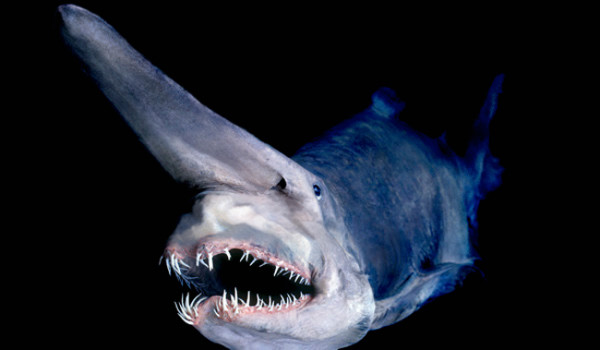located in the Pacific, east of the Philippines, is the deepest sliver of ocean there is, the Mariana Trench. Even if you put MT Everest in the trench, its peak would still be a mile deep under water. Strange creatures are lurking in the deep.
Goblin Shark
The terrifying goblin shark measures between 8 and 13 feet and was first discovered in 1898. Males can weigh up to 463 pounds, and if you weren’t scared already, you should see how they eat…


Hatchetfish
The hatchetfish has special organs capable of producing their own light. They can be found at depths ranging from 600 to 4500 feet, which is the reason they need have such protruding, sensitive eyes.

Footballfish
The footballfish is a fish vaguely shaped like a football (how creative). It uses its bulbous lure to attract prey before snatching it up with its jaws.

Frilled shark
The frilled shark is a prehistoric beast with 300 trident-shaped teeth neatly aligned in 25 rows. Scientists also believe that the frilled shark breaks the record for gestation periods amongst sharks, taking three and a half years to give birth.

Dumbo Octopus

The ear-like fins of this octopus have earned it the name “Dumbo.” The octopus lives at extreme depths of 10,000 to 11,000 feet, searching for worms and other crustaceans at the seafloor. Dumbo Octopii are about as cute as the Mariana Trench gets.

Fanfin Seadevil
Although seadevils are part of the Anglerfish family, they don’t in fact have a lure. Males can only grow to about ½ an inch in length while the female can grow up to about 8 inches. Males will fuse themselves onto the female to breed and, like a parasite, share the female’s bloodstream. That’s one overly attached boyfriend.

Dragonfish
Just like anglerfish, the dragonfish can produce its own light. The six-inch fish uses its flashing barbel (attached to its chin) to attract both prey and potential mates. The walls of its stomach are pitch black, to hide the light of any unlucky prey.

Telescope Octopus
The telescope octopus has rotatable eyes on top of long, movable stalks, giving it an incredible range of vision. Its transparent body gives it an eerie ghost-like appearance.

Barreleye
The barreleye, found at depths of 2000 feet, is most notable for its transparent head and highly sensitive eyes. The green lenses above each eye allow the fish to filter out what little sunlight makes it down to these depths and focus on the lights of its prey.

Viperfish
Found in waters 5000 feet deep, the teeth of the viperfish are so long that they can’t even fit into its own mouth. Instead, they curve back towards the eyes. The fish takes out prey by swimming at high speeds and impaling the victim with its fangs. Despite their terrifying appearance, these fish can only grow to around 12 inches in length.

Fangtooth
In proportion to its body size, the fangtooth has the largest teeth of any known fish in the ocean. While it has fearsome weaponry, it only grows to a size of six inches, meaning that it would be easy prey for tuna if it came closer to the surface.

Hirondellea Gigas
These shrimp-like crustaceans live as far down as it gets. Up to two inches long, swarms are found at depths of 30,000 feet, where food is quite scarce. Scientists found that they instead feast on tree and plant debris that occasionally make it to the bottom. Their guts produce special enzymes capable of digesting what other fish see as trash.

Ping-Pong Tree Sponge
Found at depths of around 9,000 feet, the ping-pong tree is a carnivorous sponge that can grow up to 20 inches in height. While they may not look dangerous, they are covered in tiny hair hooks which catch any small creature passing by. Then, slowly, cells in the sponge move towards the prey and digest it.

Enypniastes
Enypniastes is a deep sea cucumber which leaves nothing to the imagination and lives up to 16,400 feet down. The red area is the animal’s mouth. Around it are tentacles, which scoop up edible mud from the seafloor. From there, well, you can see.

I am in no hurry to vista this place.
